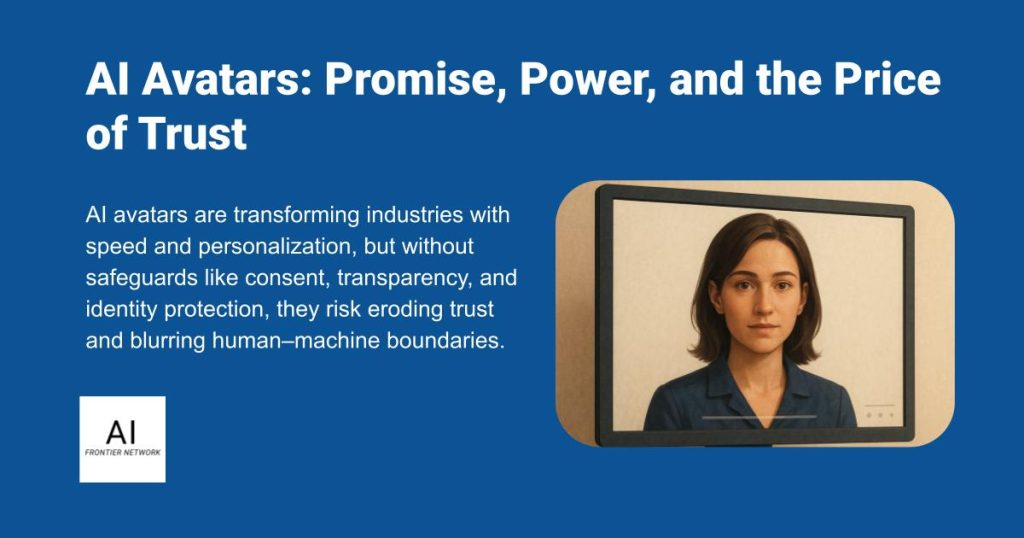
The woman on the screen leans in, her voice warm and steady. She explains the next step in your insurance claim, asks if you have any questions, and waits for your answer. She’s patient, friendly, and just human enough that you almost forget she isn’t human at all.
This is the new reality of AI avatars. They greet you in customer service chats, tutor your children, and walk patients through post-surgery care. They exist in banks, game worlds, classrooms, and clinics. And while their presence promises speed, scale, and even comfort, it also raises a question that refuses to go away: when the face you’re speaking to is made of code, how do you know you can trust it?
From Sci-Fi to Everyday Life
“AI avatars no longer feel like sci-fi toys,” says Raja Krishna. “They handle customer chats, calm patients, tutor students—and they do it instantly.”
But Krishna has seen the flip side. Over-personalization can make interactions feel invasive. Deepfake cloning can steal a face and voice before anyone notices. His solution is straightforward but firm: every avatar should carry a visible watermark, a consent trail, and plain disclosure that it’s AI.
It’s an urgent call in a market moving fast. Synthesia and HeyGen can create video avatars in minutes. Soul Machines, D-ID, and Microsoft place lifelike agents in call centers and clinics. Inworld AI and Nvidia are building game characters with nuance and personality. Meta is inching toward photoreal VR clones, while Genies, Hour One, AvatarOS, and Replika push avatars into marketing, entertainment, and personal relationships.
The Push for Personalization
In telecom, Hemant Soni has watched avatars become a kind of universal concierge. “They can greet you, help you pay a bill, walk you through a phone setup, even connect you to healthcare triage,” he says. They operate in any language, any time of day, and never get tired.
But Soni worries about what’s lost. “We risk losing human empathy, relying too heavily on automation, and opening the door to misuse.” His fix: identity verification at the core, deepfake detection baked into systems, and ethical governance that isn’t optional.
The Human Connection Question
For Pratik Badri, the stakes in healthcare are even higher. “The human connection is often the treatment,” he says. Avatars can bridge access gaps, especially for remote patients, but in medicine or counseling, simulated empathy is not the same as the real thing.
Badri insists on strict, revocable consent before using anyone’s likeness or voice, plus clear limits on purpose and duration. If harm comes from an unauthorized avatar, the platform should be held liable.
Finance expert Rahul Bhatia sees similar risks in his field. “Avatars can make complex data feel human and build trust through intelligent design,” he says. “But trust has to be there from the start, not added later like a software patch.”
Rules for the Avatar Era
In education and healthcare, Srinivas Chippagiri imagines avatars as tireless tutors or virtual nurses, tools that reduce wait times and personalize service. But he’s clear on the dangers: bias amplification, emotional detachment, and privacy loss. His defense plan includes watermarking, consent-based training data, deepfake detection, and strong legal safeguards for digital identity.
Nikhil Kassetty calls avatars “identity extensions.” That means ethics, context, and consent must “speak first” before any avatar speaks for a person.
Samarth Wadhwa stresses GDPR compliance, consent, and data minimization as defaults, especially for avatars modeled on real people.
And here, Dmytro Verner pushes the idea further. He imagines “digital personhood” rights, similar to Creative Commons licenses, that would let people control where and how their likeness appears. He wants platforms to build in misuse-reporting systems so cloned or manipulated avatars can be quickly removed. For him, the goal is clear: create helpful, human-like experiences without pretending to be human.
The Price of Trust
The people building this technology agree on one thing: AI avatars are powerful. They can reach the unreachable, work around the clock, and make systems feel human. But without boundaries, watermarks, consent, governance, and accountability, they could erode the very trust they’re meant to create.
Because the real question isn’t what these faces can do?
It’s whose face is it, and under what terms does it speak?

